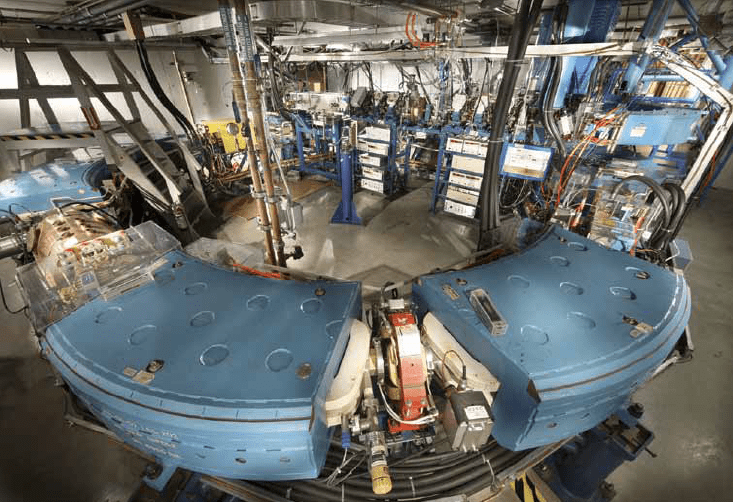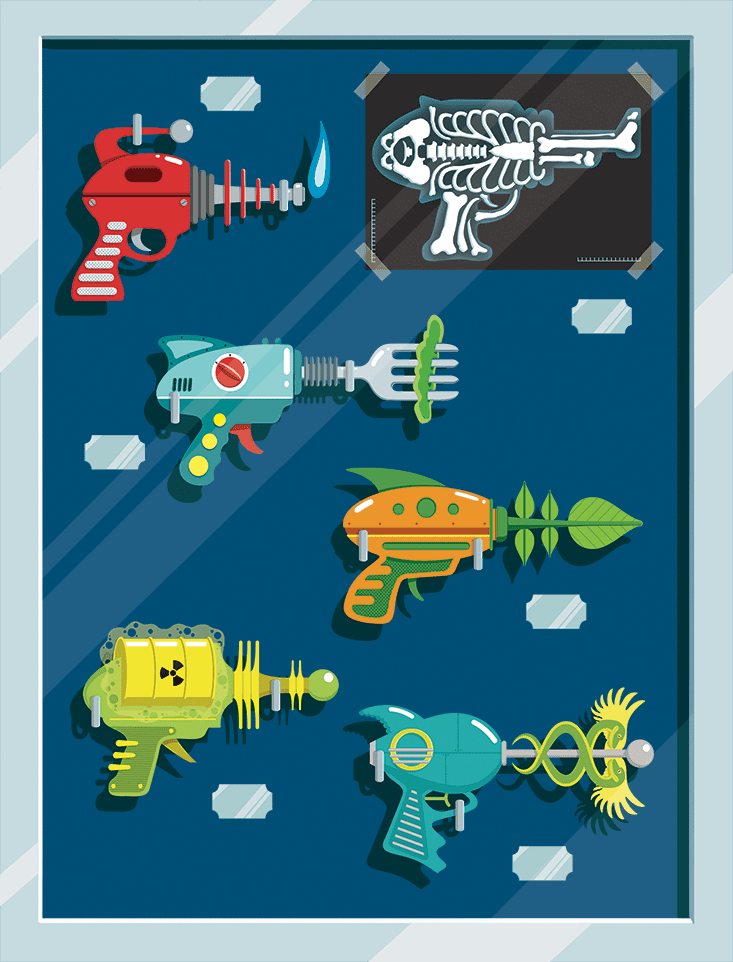Physicists use particle accelerators to answer questions of fundamental physics—how our universe was created, why objects have mass, and so on. Accelerators are huge—Fermilab’s Tevatron, near Chicago, is four miles in circumference, while the Large Hadron Collider in Geneva is more than four times that size—and extremely expensive. In some ways, they’re the epitome of the pure research instrument. But if you think these machines have no use outside of research, you’re in for a surprise.
Particle accelerators have been winding their way out of research labs and into industry for decades, and new applications continue to be dreamt up. When federal money for fundamental research dwindled, scientists started to invent new funding methods. Robert Kephart, director of the Illinois Accelerator Research Center (IARC) at Fermilab, partnered with the Illinois State Department of Commerce and Economic Opportunity to fund science research and applied applications of accelerators. In its 2009 capital bill, the state allocated $20 million toward research at Fermilab, which will be raised the same way states raise money to build roads and bridges—by selling state bonds.
Here are 10 applications of accelerators you probably haven’t heard of.
1. Is your milk carton sealed? An accelerator did it.
Accelerators use electromagnetic force to accelerate charged particles. The resulting particle beams can be directed along the desired path, including to the outside of the accelerator walls. When a charged particle moves past an atom, it can interact with the electrons in that atom, knocking them out of their orbits and breaking bonds. That can cause some chemical compounds to fall apart and others to polymerize. The latter ability has been used in one of the earliest industrial applications of accelerators, stretching back at least to the 1980s: sealing potato chip bags and milk cartons. The potato bag is made from two layers of aluminum foil held together by glue. That glue would take too long to dry on industrial conveyor belts. “It would be sticky forever,” says Kephart—but electron beams can make it happen instantly. “With an accelerator you can polymerize that glue and it’s set.”
2. A lot of natural gas is wasted. Accelerators can fix that problem.
Natural gas is harder to harness than oil and requires a pipeline to transport. That’s why millions of cubic feet of natural gas are flared or vented every year instead of being delivered to the market—a wasteful and polluting practice.
A Western Values Project estimated that the natural gas wasted in 2013 in the United States alone could support the needs of Los Angeles or Chicago for an entire year. Chemical processes can convert gas to liquid hydrocarbons, or oil, but they require high temperatures and pressures attainable only at large plants. Accelerators can achieve the same results by using electron beams to break carbon-hydrogen bonds, causing natural gas to recombine into a polymer chain. The process, which Kephart says should work in principle, still remains a technology of the future—no prototype has been built yet.
3. Want your spinach E. coli free? Accelerators may have cleaned it.
If you see this Radura symbol (left) on its packaging, your food has been irradiated with an electron beam. Over 40 countries use this technology to kill bacteria and parasites such as salmonella or E. coli in apples, strawberries, spinach, and other products. Vladimir Shiltsev, director of the Accelerator Physics Center at Fermilab, explains that the beam is calibrated so that it destroys pathogens but doesn’t affect produce.
The more complicated a molecule is, the easier it is for the beam to break it—bacterial DNA is more complex than that of a plant, so it would fall apart first. Unlike the radioactive isotopes of accidental nuclear fallout, electron beams are fully under human control, and, unlike protons or neutrons, they don’t break the atomic nuclei. “The radiation we’re talking about comes out of an accelerator, so when you turn the switch off, all radiation stops,” Kephart says. In a similar way, electron beams are used in rhodotrons, machines used for sterilization of medical devices.
4. Can coal be a clean fuel? Yes, if you attach an accelerator to the smokestack.
Burning coal produces flue gases like nitrogen and sulfur oxides: NO, NO, SO, and SO. When these gases react with atmospheric water, they turn into sulfuric and nitric acids such as HSO or HNO, eventually spilling back to earth as toxic acid rains. But when these oxides are mixed with ammonia (NH) and exposed to electron beams, they can be turned into ammonium sulfate and ammonium nitrate, common fertilizers. The reaction creates dust-like particles that could be gathered with an electrostatic or centrifugal particle separator and put on the field.
Kephart sees the idea as an opportunity to make coal a cleaner fuel. “Even with the most optimistic projection of renewable energy sources and nuclear power, coal is likely to be providing 20 percent of our energy 20 years from now,” he says. “This is a way to make it more environmentally acceptable.” PAVAC, a company in British Columbia, Canada started by Ralf Edinger,1 is working on its first installation of this technology.
5. Antibiotics harm fish? Accelerators can turn pharmaceuticals into fertilizer.
Accelerators can clean up sewage sludge by removing nitrogen and phosphorus, which cause algal blooms, and also hormones and antibiotics, which harm fish. Exposing sewage waste to electron beams breaks pharmaceuticals into harmless compounds. The beams ionize the water, producing H3O+ and OH radicals and creating a highly reactive environment in which oxidation and reduction reactions happen. This solution can break complex pharmaceutical compounds into basic elements, and kill pathogens as well. “Irradiated sludge can become a material that you could put on a lettuce field,” Kephart says.
A pilot accelerator plant that cleaned municipal waste was built in Miami, Florida in the early ’90s. Although the plant worked, it wasn’t a turn-key solution, Kephart says, so the idea was never commercialized. “An organization buying a municipal waste plant needs a fully developed system,” he explains, but “it was too soon for the industry to fund it.”
6. Your new computer has arrived. Thank an accelerator for building it.
Breaking down molecules and destroying pathogens’ DNA are not the only tricks accelerators can do—they also help build new materials. The computer chip industry relies on a technique called doping, in which boron and phosphorus ions are implanted into layers of silicon using accelerators. Ions are positively charged, so accelerators can direct ion beams with electromagnetic fields. The ions penetrate the surface of the silicon wafer and are deposited at precise locations inside it. That changes the conductivity of the material.
7. Accelerators make us live longer. They kill cancer.
Electron beams aren’t the only charged particles capable of killing unwanted life. Protons can destroy tumors, and are a good match for radiation therapy because they have stronger penetrating power than electrons. They can pass through tissues causing little damage, but killing cells where they stop.
“Protons lose most of their energy and produce most of the harm, radiation harm, at the very end of their path,” Shiltsev says. This allows scientists to calibrate accelerators to deliver their destructive power to the precise location of the tumor. The concept was pioneered in 1946 by Robert Wilson, Fermilab’s first director. Nearly half a century later, the first medical proton-beam accelerator began operating at Loma Linda University Medical Center.

8. Can nuclear reactors be accident-proof? Yes, if particle accelerators control them.
Traditional nuclear reactors are critical reactors—they produce excess neutrons that must be absorbed by control rods to regulate the reaction. The problem is the rods are susceptible to mechanical issues, which can cause the reaction to spiral out of control. Accelerator-driven subcritical systems control the amount of neutrons that are supplied instead of consuming the excess neutrons.
In accelerator-driven atomic reactors a proton beam would hit a heavy metal target such as mercury or lead, producing a “spray of neutrons,” which then drive the nuclear fission, says Kephart. That is a safer design, he points out, because “when you switch off the accelerator the nuclear reaction stops.” Accelerator-driven reactors would also be able to break the already existing nuclear waste into short-lived isotopes. No such reactors have been built yet, but Europe, India, and China are pursuing the idea, Kephart says.
9. The world still runs on oil. Accelerators can find it.
Portable Neutron Generators (or neutron tubes) help detect oil, gas, or water deposits using a technique called neutron logging. During the discovery process, neutron generators are placed into exploratory boreholes. As the neutrons produced by the accelerator pass through the ground surrounding the borehole, they interact with the atomic nuclei of various materials. That produces gamma rays which can be picked up by gamma-ray detectors. The strength of these signals reflect the type of materials buried underground. “Usually people look at the signatures of reactions,” says Shiltsev. “If there is a pore, less gammas will come out.” Oil and water will produce different amount of gamma rays, too.
10. Accelerators keep watch for weapons of mass destruction.
Muon accelerators enable us to literally see through walls. Muons—subatomic particles similar to electrons but with a greater mass—can easily pass through thick and heavy steel walls and containers, but will react with nuclear material. If a truck, perhaps driving by a border patrol, is carrying concealed fissile materials, muons sent through the truck will produce high energy gamma-rays which can be detected.
This makes muon accelerators invaluable in identifying nuclear threats. For example, helicopters could fly muon accelerators over water, beaming muons down onto cargo ships. “You can remotely send the beams of radiation which selectively interact with the materials and can tell you whether a particular material is present on the boat or not,” Shiltsev says. “You can figure out whether this boat carries nuclear bomb parts.”




